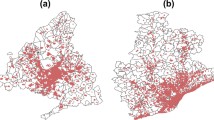Abstract
In this paper a tool of representation of the relative mobility is presented, that couples to the ordinary mobility table as a means of representation of the absolute mobility. From the statistical point of view it is connected to the tradition of “ransacking” mobility tables through odds ratios (Goodman, 1969), whereas the sociological inspiration came from the work of Goldthorpe (1980) on relative mobility.
The first section presents the underlying logic and the simple computations involved in the construction of the “relative mobility table” and shows the main properties of the coefficients (“generalized odds ratios”) here used for the study of the “mobility regime”. The second section discusses some other uses of the ralative mobility table data.
Similar content being viewed by others
References
Alba, R.D. (1987). “Interpreting the parameters of log-linear models,” Sociological Methods & Research 16: 45–77.
Bishop, Y.M.M., Fienberg, S.E. & Holland, P.W. (1975). Discrete Multivariate Analysis. London: The MIT Press.
Blau, P.M. & Duncan, O.D. (1967). The American Occupational Structure. New York: Wiley.
Boudon, R. (1973) Mathematical Structures of Social Mobility. London: Elsevier.
Cobalti, A. (1988a). “Alternative conceptual frameworks for the analysis of mobility tables and the log-linear models”, Quality & Quantity 22: 31–47.
Cobalti, A. (1988b). “Mobili e disuguali”, Polis, 2, 1: 53–82.
Featherman, D.L. & Hauser, R.M. (1978). Opportunity and Change. New York: Academic Press.
Featherman, D.L., Jones, F.L. & Hauser, R.M. (1975). “Assumptions of social mobility research in the U.S.: the case of the occupational status”, Social Science Research 4: 329–60.
Goldthorpe, J.H. (in collaboration with C. Llewellyn and C. Payne). (1980). Social Mobility and Class Structure in Modern Britain. Oxford: Clarendon Press.
Goodman, L. (1969). “How to ‘ransack’ social mobility tables and other kinds of crossclassification table”, American Journal of Sociology 75: 1–40.
Hout, M. (1983). Mobility Tables. New York: SAGE.
Kaufman, R.L. & Schervish, P.G. (1986). “Using adjusted crosstabultations to interpret log-linear relationships”, American Sociological Review 51: 717–33.
Kaufman, R.L. & Schervish, P.G. (1987). “Variation on a Theme. More uses of odds ratios to interpret Log-linear parameters”, Sociological Methods & Research, 16: 218–53.
Kappelhof, P. & Teckenberg, W. (1987). “Intergenerational and career mobility in the Federal Republic and the United States” 3–49 in W.Teckenberg (ed.), Comparative Studies of Social Structure. New York: M.E. Sharpe Inc.
Tyree, A. (1973). “Mobility ratios and association in mobility tables”, Population Studies 27: 577–88.
Author information
Authors and Affiliations
Rights and permissions
About this article
Cite this article
Cobalti, A. A relative mobility table. Qual Quant 23, 205–220 (1989). https://doi.org/10.1007/BF00151904
Issue Date:
DOI: https://doi.org/10.1007/BF00151904




